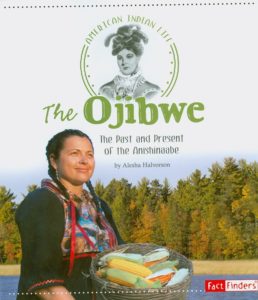Book review: The Ojibwe: The Past and Present of the Anishinaabe
The Ojibwe: The Past and Present of the Anishinaabe is part of the American Indian Life series published under the Fact Finders book label by Capstone Press. The book is aimed at a young grade school age audience – up to Grade 4 or 5. It consists of four chapters – “Early Life”, “Loss and Change”, “Life Today”, and “Connecting to the Past”, as well as an introduction, timeline, glossary, places to find more information, and a few questions designed to aid in understanding and interpreting the work’s contents. These chapters contain useful text boxes explaining key terms or interesting information. The work is also nicely illustrated with historic and contemporary images and photographs; unfortunately, the glossary, while helpful for the young reader, contains only English language terminology. In fact, throughout the entire book, there are only six Anishinaabemowin words presented – Anishinabe, otchipwa, manoomin, gimaa, Gitchi Manitou, and Midewiwin. The lack of more Anishinaabemowin is a missed opportunity – for instance, Halvorson could have presented Tiginaagan as well as Cradleboard.
The timeline provided in The Ojibwe is problematic and highly United States focussed. The U.S. focus is a problem with the book overall; the references to Anishinaabeg in Canada are almost non-existent (confined to population numbers only). Even the map designed to show traditional lands and reserves only shows reserves in Northern Wisconsin, Minnesota and North Dakota, which creates the impression that there are no Ojibwe in Michigan, Ontario, Manitoba, or Saskatchewan. Despite these issues, the author does provide an age-appropriate discussion of the Anishinaabeg.
The introduction begins with a very brief description of the importance of the powwow, specifically that it celebrates Ojibwe culture, history, and community. This sets up the following four chapters. The first chapter describes the origin of the ‘tribal name’, migration into the Upper Lakes, housing, food, seasonal movements, as well as definition of band, tradition, and ancestor.
Chapter 2, deals with the effects of contact, disease, and warfare as well as colonialism, boarding schools, and land loss from the 1600s to the 1900s. This historical narrative is presented in a moderate way so as to emphasize the ‘effects’ for the young reader without unduly offering details that would cause distress.
Chapters 3 and 4 deal nicely with the contemporary lives of the Anishinaabe and how the ‘western or modern’ culture is melded or blended with the ongoing of tradition. The intent here is to illustrate that ‘real Indians’ are still here and practising our cultures. Despite Halvorson’s efforts to show our modern culture, her regular emphasis on past practises with very brief sidebars on contemporary activities does not adequately do this at times. Her descriptions of sport, food, and clothing for instance emphasize the past rather than blending with the contemporary.
Finally, her discussion of craft not only reduces our art to something less, but also fails to include the development of contemporary forms of art, sculpture and literature. The book ends with a return to the powwow, with a fuller description of its importance and ceremony.
Overall, I would not recommend this book to parents or schools seeking to use the work as a resource. This is particularly the case for residents in Canada. Its emphasis on the U.S., lack of Anishinaabemowin terminology, and missed opportunities with contemporary culture render the work’s utility questionable.
Alesha Halvorson, The Ojibwe: The Past and Present of the Anishinaabe, North Mankato, Minnesota: Capstone Press, 2017.



